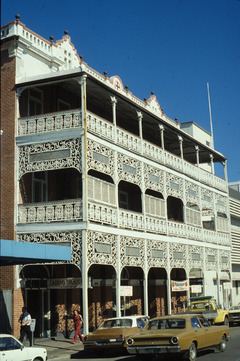Type Hotel Construction started 1909 Floors 3 | Architectural style Filigree Completed 1903 (1903) Opened 1903 Destruction date 1982 | |
 | ||
Former names Prince of Wales (1902–1903) Address 12 Sturt StreetTownsville, QLD | ||
Buchanan's Hotel (nicknamed "Buchs") was a hotel on Sturt Street located in the CBD of Townsville, Queensland, Australia. The three-storey structure, with an ornate wrought iron facade, was completed in 1903. It was used as a hotel from 1903–39, and during World War II to house American officers. It caught fire and was destroyed in 1982.
Contents
Construction and early history
Buchanan's Hotel in Townsville was built in 1903, with an ornate wrought iron and stained-glass facade in the Filigree style covering its front verandas. It was named for its owner, David Buchanan, who built it to replace his previous hotel, Prince of Wales, which sat on the same spot and was destroyed by fire in April 1902. Initially named the Prince of Wales after its predecessor, David Buchanan's pride in his building was such that in May 1903 he officially changed its name to match his own. The building, of three storeys, was later described as being "decorated with splendid ironwork".
Buchanan, a first-generation Scottish immigrant who owned multiple hotels in his lifetime, spared no expense in the construction of his eponymous pub: Buchanan's featured high-ceilinged bedrooms, gas lighting, electric bells to summon staff members and running water to wash stands in every room. It also contained a five-hundred square foot dining saloon, and the wrought-iron "iron lace" facade was created by Green's Foundry in Townsville. Its construction cost £12000, and it was the last hotel David Buchanan built before his death in 1913. He claimed that it stood "easily first in north Queensland", though commentators have suggested this claim might have been overstated slightly.
The architecture was a particularly notable feature of Buchanan's, one that would later lead to its display on an Australia Post stamp. Dorothy and Bruce Gibson-Wilde note this in their 1988 book, A Pattern of Pubs: Hotels of Townsville 1864-1914:
Townsville's two most elaborate hotel buildings, the Queen's and Buchanan's, were designed in the same year (1902). Both mixed the exposed brick and painted plaster detailing of the Federation era with iron lace, more typical of the nineteenth century. Buchanan's was justly famous for its superb cast and wrought iron.
The Second World War and Lyndon Johnson
Lyndon Johnson, later to become United States President, stayed at Buchanan's on 8 June 1942 when it was a lodging for American officers during World War II - a visit which he repeated during a Presidential tour of Australia on 23 October 1966. On that same day, he mentioned the hotel in his speech to a Townsville crowd estimated at 50,000.
After the Second World War
After the war the Hotel was abandoned and left standing empty, and by the 1960s the top story was unstable and unusable. In 1973, it was featured on an Australian postal stamp as part of a series of stamps depicting beautiful buildings. Other buildings featured included the Sydney Opera House, Como House in Melbourne and St. James Church in Sydney.
In 1982, the hotel was destroyed in a fire. The current owner, developer Bill Spee, has announced plans to build a "green" office block on the site.
Notable guests
Buchanan's hosted a number of notable Australians and others during its history, including:
